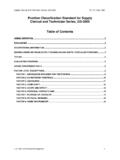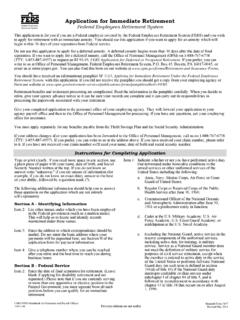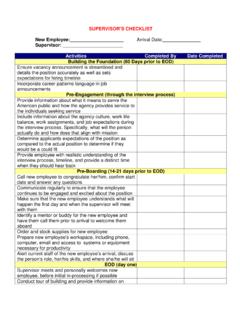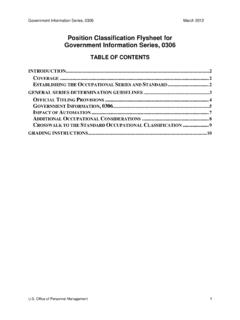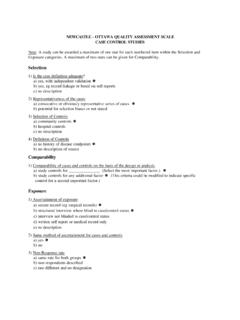Transcription of Report on Locality-Based Comparability Payments for the ...
1 Report on Locality-Based Comparability Payments for the General Schedule Annual Report ofthe President's Pay Agentfor Locality Pay in 2022 Page b is intentionally left President s Pay Agent Washington, DC December 15, 2021 Memorandum for the PresidentSubject: Annual Report on General Schedule Locality-Based Comparability Payments Section 5304 of title 5, United States Code, requires the President s Pay Agent to submit a Report to the President each year showing the Locality-Based Comparability Payments we would recommend for General Schedule (GS) employees if the adjustments were to be made as specified in the statute. To fulfill this obligation, this Report shows the adjustments that would be required in 2022 under section 5304, absent overriding legislation or exercise of your alternative plan authority to control locality pay.
2 Section 5304 stipulated that by January 2002 locality rates would not be less than the full amount necessary to reduce the pay disparity in each locality pay area to 5 percent, and the pay disparities in this Report fulfill the statutory requirement to submit a Report eac h year showing the Locality-Based Comparability Payments the Pay Agent would recommend for GS employees if t he adjustments were made as specified in the statute. However, the statutory formula for locality adjustments has not been followed since January 1994 because of budgetary and methodological concerns. Regarding budgetary concerns, this Report includes an estimated cost of $ billion for reducing disparities as intended by the statute, and that cost is a significant consideration.
3 However, it is also important to emphasize that the underlying methodology for locality pay of relying on one singular locality rat e covering a locality pay area has lacked credibility since the beginning of locality pay in 1994 to such a degree that the statutory formula for closing pay gaps has been overridden either by Congress or by successive Presidents each and every year since that first year. The Federal Salary Council contributes substantial advice to the administration of the locality pay program, and we appreciate the Council s public deliberations and recommendations for the administration of locality pay for the Government s million employees who are paid under the General Schedule.
4 At the time of this Report , a new Federal Salary Council has not yet been appointed by the Biden Administration. Several of t he issues addressed in this Report , therefore, should be considered again once a new Council has been established. We are issuing this Report in the meantime, however, because it is essential for pay administration purposes that we close out the work of the prior Council. There are many technical issues that the Council considers that are necessary for setting pay for the next year, so we recommend moving ahead so as not to leave critical pay administration issues unresolved. The Council s recommendations for locality pay in 2022 are included in Appendix I of this Report .
5 With the caveat that we are lacking the input of a new Council appointed by the Biden-Harris Administration, we acknowledge that the methods the Council used to calculate the locality pay rates that would go into effect in January 2022 absent another provision of law are appropriate. We also recommend further Council study on the question of whether the GS employment threshold of 2,500 or more GS employees should change for evaluating Rest of metropolitan areas called Rest of research areas for possible establishment as new locality pay areas based on pay disparities calculated using the current salary survey methodology. At this time, we are unable to agree to implement all of the Council s January 2021 recommendations for locality pay in 2022.
6 The Council members provided significantly divergent views on the complex issues of administering the locality pay program at its public meeting in October 2020. For example, one issue with divergent points of view was whether pay area boundaries should be changed to reflect recent updates to Office of Management and Budget delineations of metropolitan statistical areas and combined statistical areas (MSAs and CSAs). Similarly, recent Council discussions indicate further study is also needed on the question of whether to change or make exceptions to the criteria by which areas of application are established. Any Council recommendations to change or make exceptions to the criteria by which basic locality pay areas and areas of application (as defined in Attachment 5 of the Council s January 2021 recommendations) are established should discuss and quantify the implications that such changes or exceptions could have on all potentially impacted locations throughout the Country before the Pay Agent would consider them.
7 Further deliberation on these important matters is warranted by the new Council, once constituted. We look forward to providing staff support for the Council s upcoming deliberations on locality pay under your Administration and hearing the views of all of the members for locality pay in 2023. However, as has been noted in earlier Pay Agent reports and discussed in other venues, we believe there is a need to consider major legislative reforms of the white-collar Federal pay system, which continues to utilize a process requiring a single percentage adjustment in the pay of all white-collar civilian Federal employees in each locality pay area without regard to the differing labor markets for major occupational groups.
8 The current pay comparison methodology used in the locality pay program ignores the fact that non-Federal pay in a local labor market may be very different between different occupational groups. As currently applied, locality Payments in a local labor market may leave some mission-critical occupations significantly underpaid while overpaying others. The President s Pay Agent: SIGNED_____ Martin J. Walsh Secretary of Labor SIGNED_____ Shalanda Young Acting Director, Office of Management and Budget SIGNED_____ Kiran A. Ahuja Director, Office of Personnel Management Page f is intentionally left of ContentsPage Introduction .. 1 Across-the-Board and Locality Adjustments.
9 3 Locality Pay Surveys .. 5 Comparing General Schedule and Non-Federal Pay .. 9 Locality Pay Areas .. 13 Pay Disparities and Comparability Payments .. 21 Cost of Locality Payments .. 23 Recommendations of the Federal Salary Council and Employee Organizations .. 25 Tables 1. Example of NCS/OES Model Estimates Procurement Clerks Washington, DC .. 9 2. Local Pay Disparities and 2022 Comparability Payments .. 21 3. Remaining Pay Disparities in 202022 .. 4. Cost of Local Comparability Payments in 2022 (in billions of dollars) .. 24 Page h is intentionally left IntroductionThe Federal Employees Pay Comparability Act of 1990 (FEPCA) replaced the nationwide General Schedule (GS) with a method for setting pay for white-collar employees that uses a combination of across-the-board and location-based pay adjustments.
10 The policy contained in 5 5301 for setting GS pay is that (1)there be equal pay for substantially equal work within each local pay area;(2)within each local pay area, pay distinctions be maintained in keeping withwork and performance distinctions;(3)Federal pay rates be comparable with non-Federal pay rates for the samelevels of work within the same local pay area; and(4)any existing pay disparities between Federal and non-Federal employeesshould be completely across-the-board pay adjustment provides the same percentage increase to the statutory pay systems (as defined in 5 5302(1)) in all locations. This pay adjustment is linked to changes in the wage and salary component, private industry workers, of the Employment Cost Index (ECI), minus percentage points.




